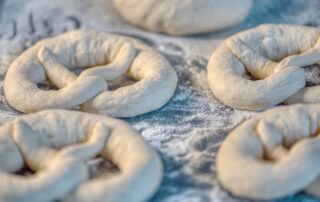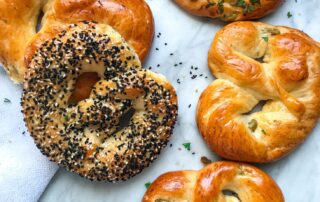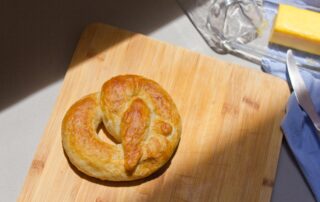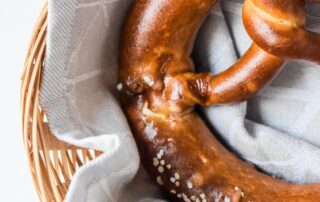 Pillar: Sacramental Ecology
Pillar: Sacramental Ecology
Laudato Si’ Action Plan Goals: Ecological Spirituality, Ecological Education, Adoption of Simple Lifestyles
 Pillar: Sacramental Ecology
Pillar: Sacramental Ecology
Laudato Si’ Action Plan Goals: Ecological Spirituality, Ecological Education, Adoption of Simple Lifestyles
Group (Grade Levels): Works best for high school students or young adults; can be adapted for younger ages
Learning Goals:
- Experience and understand how simple, natural ingredients work together in a process to create delicious and nourishing food.
- Recognize and understand how God’s Word (Scripture) affirms the intrinsic goodness of creation and reveals God’s providential care through created matter.
- Recognize and appreciate connections between “pre-Eucharistic” food experiences and active participation in sacramental life, especially the Eucharist.
Materials Needed: table or kitchen counter to prepare pretzel dough; ovens to bake pretzels; food preparation tools (per batch): large mixing bowl, small mixing bowl, mixing spoon, measuring utensils, baking sheet, parchment paper, pencil, pastry brush; ingredients (per batch): 1 pkg. (= 2 ¼ tsp.) yeast; 1 ½ c. warm water, 1 T. sugar, 1 tsp. salt, 4 c. flour, 1 egg, additional salt as desired. (Optional: wheat and grapes or related Eucharistic symbols for display.)
Estimated Time to Complete Activity: 1½ – 2 hours (includes baking time)
General Outline of Experience
- Ask a volunteer to read Laudato Si’, n. 236 on the Eucharist: “It is in the Eucharist that all that has been created finds its greatest exaltation. . . Thus, the Eucharist is also a source of light and motivation for our concerns for the environment, directing us to be stewards of all creation.”
- Allow participants to share responses to the text: questions, key words or phrases, surprises, etc.
- Explain that we will be learning more about the Eucharist in relation to all of creation through our work and prayer in this experience.
- Conclude with the “Our Father.”
-
- As numbers allow, break participants into up to five groups. (Groups should have at least three or four members.) Each group will receive one copy of a New Testament texts related to the Last Supper and the context for the institution of the Eucharist: 1 Cor. 11:24, Mt. 26:26-30, Lk. 22:24-30, Jn. 13:1-15, Mk. 14:22-26. Do not introduce or reveal the content of the passages to the whole group. Before distributing the texts, instruct participants that they will work as a small group for 10 minutes to develop a way to present the text to the rest of the participants. They may speak or act in silence, use available furniture and/or props, and move within the designated space. They may not read the passage aloud as part of their presentation. After distributing the texts to each group, circulate to see how they are doing and assist as needed.
- When small groups are ready, have each one present to the whole group. Applaud for each group without commenting until all groups have presented.
- After all groups have presented, discuss any observations. See if participants can identify the origin of other passages and common themes. Compare and contrast the similarities and differences between the texts, reminding participants that each text relates to the institution of the Eucharist at the Last Supper and reveals a portion of the meaning of Christ’s action in this Sacrament.
Explain to participants that we will be preparing and baking soft pretzels using simple ingredients and tools. Encourage them to work together to allow each person to participate in the process. Explain that we will take each ingredient and each step of the process slowly and intentionally, introducing ingredients and tools as needed, with reflection on each element.
- Gather and organize ingredients and tools ahead of time. As desired, stage materials separately from participant workspace, and introduce ingredients and tools one at a time as needed. If possible, have a table for serving the pretzels decorated with wheat and grapes or with other related symbols of the Eucharist. When ready to begin preparing dough, preheat the oven to 350 degrees Fahrenheit.
- One batch of pretzel dough works well for 8-10 sizeable pretzels. Group size is best with eight or fewer participants.
- One participant adds 1½ c. warm water to large mixing bowl.
- Another participant sprinkles one package (2¼ tsp.) yeast into the bowl. Participants can gently stir the yeast into the water.
- Another participant adds 1 T. sugar to the bowl, followed by stirring.
- Pause after the first three ingredients to discuss the role of each ingredient, followed by reading and discussing each of the relevant Scripture passages:
- Why is the water warm? Guide participants to explain that the water is a suitable environment for the yeast. Water that is too cold will not activate the yeast; water that is too hot will kill the yeast. Assess participants’ understanding of the nature of yeast as a living organism. (If appropriate for the group, consider reflecting on the womb as a suitable environment for a growing child.)
- Why do we add sugar? Explain that, as we may be hungry when we wake up in the morning, so yeast activated in the warm water is “hungry” and feeds on sugar. Yeast processes the sugar to release the gas that will allow the dough to rise.
- A participant proclaims Jn. 4:1-14. Discuss this passage and the significance of water in our own experience of physical and spiritual life.
- A participant proclaims Mt. 13:33. Guide participants to observe that Jesus understands the baking process! He is present to us as we prepare these pretzels. Discuss what Jesus means when he compares the kingdom of heaven to yeast.
- A participant proclaims Ps. 119:103. Explain that cane sugar was not available to the psalmist and that honey was the natural sweetener in that context. Discuss what the psalmist means in describing God’s law as sweeter than honey.
- A participant adds 1 tsp. salt, followed by stirring. Discuss why we add salt (both for flavor and to balance the yeast’s response to the sugar). A participant proclaims Mt. 5:13. Discuss what Jesus means by describing his disciples as “salt of the earth.”
- Ask participants what main ingredient we are missing (flour!). Explain that we are now going to add flour gradually, stirring in each cup and assessing if more is needed, until we reach a desired consistency that is elastic but not sticky. Kneading within the bowl or on a floured surface may be helpful. Once the dough acquires the desired consistency, a participant proclaims 1 Kgs. 17:9-16. Discuss the various roles and meanings of flour in this passage.
- A participant divides the prepared dough into the number of pretzels to be formed (e.g., one per participant or desired number per batch). Participants may knead and shape their dough as they desire. (If desired, research the association between Lent and the tradition cross-shaped pretzel to share with participants here.)
- When finished forming their dough, participants place their pretzels on parchment paper on a baking sheet. Participants write their name or initials on the parchment paper next to their pretzel.
- A participant cracks an egg into a bowl and uses a fork or pastry brush to beat the egg. Participants use the pastry brush to coat the top of their pretzels with the egg wash. Participants may also sprinkle salt on their pretzels as desired. A participant proclaims Lk. 11:9-13. Discuss the contrasts Jesus offers in this passage and what he reveals about God the Father and God the Holy Spirit.
- Place the baking sheet in the oven and check after 12-15 minutes. Fully baked pretzels should be golden on top and sound hollow when tapped. Pretzels can cool on the baking sheet until ready to eat.
- While pretzels are baking, participants proclaim and discuss one or more of the following passages:
- Mt. 14:13-21. Guide participants to interpret the passage. Prompt participants to identify the four verbs the author uses to describe Jesus’ action (take-bless-break-give).
- 1 Cor. 11:23-26. Guide participants to discuss the passage. What four verbs does St. Paul use in recounting the institution of the Eucharist?
- Lk. 24:13-25. Guide participants to identify a “Liturgy of the Word” and “Liturgy of the Eucharist” structure to this passage. What four verbs does Luke use to describe what Jesus does in the village? When and how do the disciples recognize Jesus?
While enjoying the pretzels, invite participants to reflect on and share their experiences of the process.
-
- What did they enjoy most and/or least about the dough preparation?
- Which Scripture passages(s) stood out to them?
- Direct participants’ attention to the Eucharistic symbols of wheat and grapes. Why are these appropriate symbols of the Eucharist? Does the celebrant receive wheat and grapes during the Liturgy of the Eucharist? Guide participants to recognize that wheat becomes bread and grapes become wine through a process requiring human activity. While God has given us the natural ingredients to nourish our bodies, Jesus did not choose natural ingredients as they are to become the Eucharist; rather, he chose to use food and drink that reflects human participation.
- In addition to the hosts and altar wine which become the Eucharist, guide participants to consider other ways they can “give themselves” to Christ in the Eucharist.
Once participants have had sufficient opportunity to share their experiences and reflections, close by reflecting on the Eucharist in the life of St. Francis.
- Explain that although he was not a priest, St. Francis of Assisi reverenced priests, churches, and everything related to the Eucharist.
- Francis wrote beautiful reflections on the Eucharist. Choose one or both of the following as a closing prayer to conclude this experience:
- “Behold, each day he humbles Himself as when he came from the royal throne into the Virgin’s womb; each day He himself comes down to us, appearing humbly; each day He comes down from the bosom of the Father upon the altar in the hands of the priest. As he revealed himself to the holy apostles in true flesh, so He reveals himself to us now in sacred bread.” (Admonitions)
- “Let everyone be struck with fear, let the whole world tremble, and let the heavens exult when Christ, the Son of the living God, is present on the altar in the hands of a priest! O wonderful loftiness and stupendous dignity! O sublime humility! O humble sublimity! The lord of the universe, God and the Son of God, so humbles himself that for our salvation he hides himself under an ordinary piece of bread! Brothers, look at the humility of God, and pour out your hearts before him! Humble yourselves that you may be exalted by him! Hold nothing back of yourselves for yourselves, that he who gives himself totally to you may receive you totally!” (Letter to the Entire Order)
Bread-baking; host-making; wheat retreat
Cross-references to related experiential activities: Cooking Together, Garden Work, Canning and Food Processing




